I am a little rat who finds interesting things in old books sometimes
Don't wanna be here? Send us removal request.
Photo

why is this sentence written with such perfect comedic timing
#ah victorian/edwardian pharmacology#where the adjuvant in the heroin syrup is nightshade#early 1900s#medical history#medicine#i had to read this several times before i understood that the ounces listed are bottle sizes and NOT doses#so it's more like... 3.2 mg of heroin per dose#which i guess is a reasonable amount of heroin compared to what i thought we were dealing with
309K notes
·
View notes
Photo
From The Strand no. 13, January 1892, via fakehistoryhunter:

“A Snow Lady.” The accompanying picture shows what can be done with snow, by those who care to exercise their powers of modelling, and produce something more natural in appearance than the familiar old “Snow Man,” built up after the figure of a Lowther Arcade Noah*. During a lull in the severe frosts of last winter, two ladies (amateurs, who had never had a lesson in modelling), with the assistance of only a shovel and pair of scissors, erected and modelled the “Snow Lady” in a garden near Pangbourne. No foundation of any kind was used, and no sticks or wires were concealed under the figure for the purpose of supporting head, body, or arms. An enlargement of the original photograph was shown at the Photographic Exhibition during last autumn, and gave rise to many remarks, sage and otherwise. A large number of those who looked at it pronounced it as “No doubt very cleverly got up–but all humbug!” “Real snow? Not a bit of it! Quite impossible!”
*Meaning, a simplified shape, like the carved figures in the Noah's Ark toysets that were popular in the Victorian era. Lowther Arcade was a shopping arcade in London from 1830 to 1902. You can spot a Noah's Ark on display in this illustration from the article; it probably looked something like this or this.

Two Victorian ladies making a Snow Lady in 1891
#1890s#real or fake#the strand#I'm calling shenanigans—the arm couldn't stand out like that just made of snow#and the Victorians loved some photo manipulation#maybe a doll and some perspective trickery?
12K notes
·
View notes
Text

2 notes
·
View notes
Text



Sample text used for typeface specimens, MacKellar, Smiths & Jordan Co., 1892.
2 notes
·
View notes
Text

Shadowgraph of "ectoplasm", 1921
Made by Dr. E. E. Fournier d'Albe during a séance with Irish medium Kathleen Goligher. In his account of the séance, d'Albe remarked that "The photograph gives a strong suggestion of chiffon or other textile material," and in another sitting he saw "an object resembling a piece of white muslin or chiffon about the size of a man’s handkerchief" between the medium's feet.
6 notes
·
View notes
Text

Mrs. Maybrick's Own Story: My Fifteen Lost Years
In 1889, Florence Maybrick was convicted of the murder of her husband, Liverpool cotton merchant James Maybrick, by arsenic poisoning. Days before her execution, her sentence was commuted to life imprisonment. She served 15 years in Woking and Aylesbury prisons before finally being freed.
But did Florence really kill her husband? James, a bit of a hypochondriac, habitually took arsenic for its supposed medicinal properties. Even on his deathbed, he begged his wife to put the powder in his food. Arguably, Florence was actually convicted of infidelity—something men (including her husband) could get away with, but women could not.
Speaking of James Maybrick: if that name sounds familiar, you may be thinking of the theory that he was actually Jack the Ripper, which stems from the publication in 1993 of a diary of dubious provenance. Florence Maybrick, meanwhile, actually did write her own story, which you can read here.
9 notes
·
View notes
Text
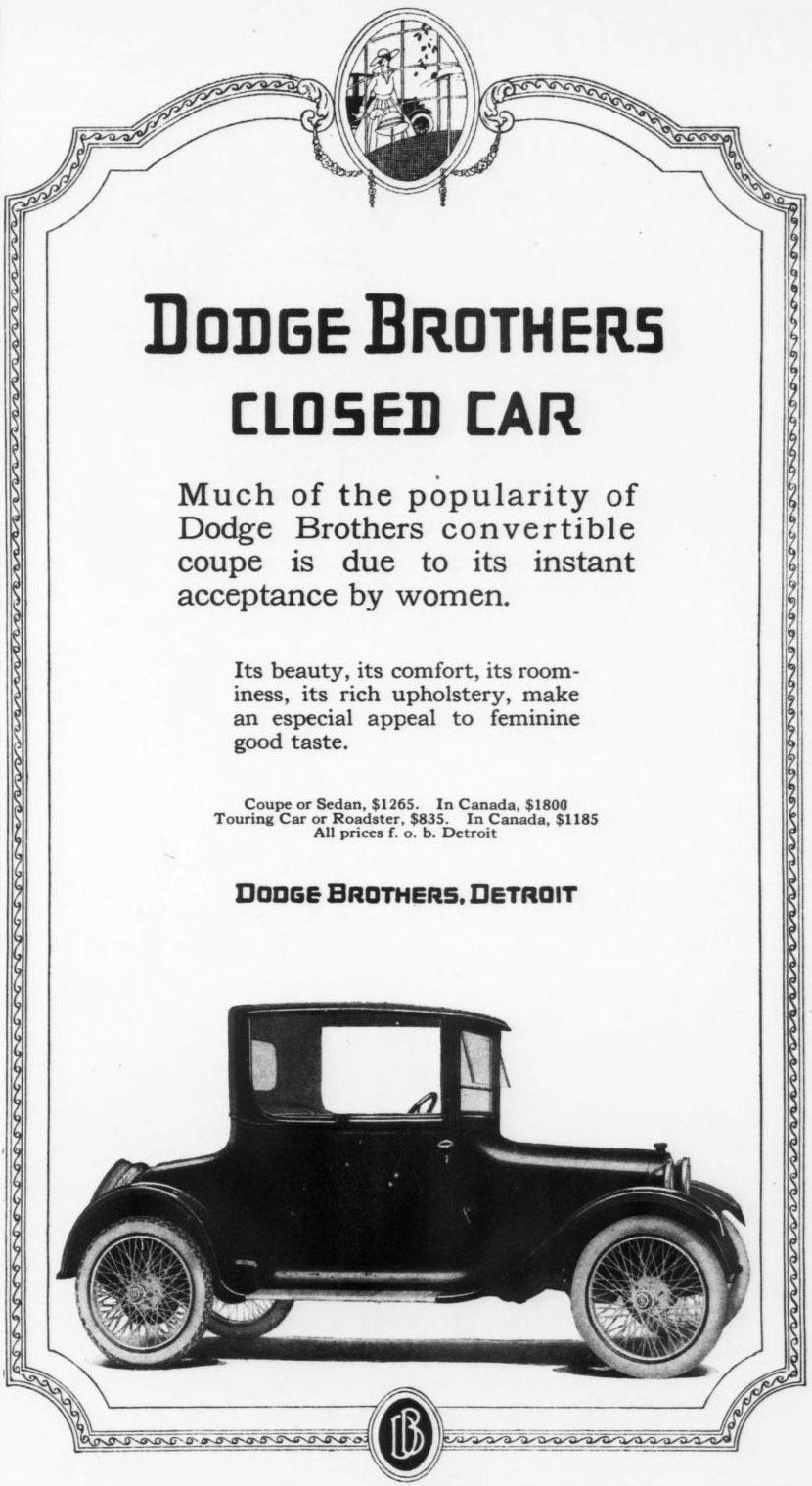
Dodge Brothers closed car
Much of the popularity of Dodge Brothers convertible coupe is due to its instant acceptance by women. Its beauty, its comfort, its roominess, its rich upholstery, make an especial appeal to feminine good taste. Coupe or Sedan, $1265. In Canada, $1800. Touring Car or Roadster, $835. In Canada, $1185. All prices f. o. b. Detroit. Dodge Brothers, Detroit
Advertisement for a Dodge Brothers closed car, from Good Housekeeping, July 1917.
5 notes
·
View notes
Text

Advertisement for Magic: Stage Illusions and Scientific Diversions, Including Trick Photography, by Albert A. Hopkins, 1898.
From Scientific American: Building Edition, vol. 25, no. 2, February 1898.
#old books#vintage books#vintage ads#advertisement#magic#1890s#United States#scientific american#albert a hopkins
1 note
·
View note
Text

Iconic 90's fashion (1890s, that is): the wallet chain
Advertisement in Scientific American, Building Edition, vol. 25, no. 2, February, 1898.
A bunch of keys will not get lost or be left in the door if you fasten it to your pocket with one of these key chains. Holds firm and does not tear the cloth. With steel chain. By mail for 10 cents. Aluminum or phosphor bronze 25 cents. Other useful novelties made with Improved Washburne Patent Fasteners, described in an illus. booklet, you can have for the asking. American Ring Co., Box P, Waterbury, Conn.
#historical fashion#wallet chain#1890s#united states#old books#vintage books#scientific american#vintage ads
14 notes
·
View notes
Text
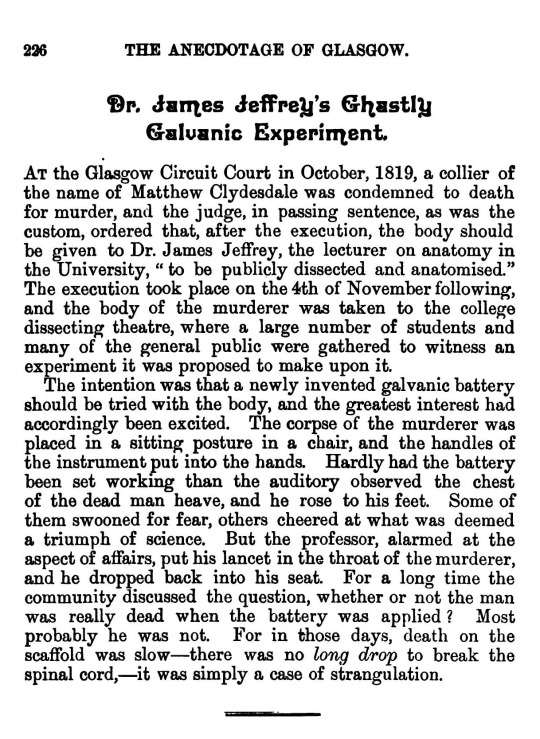
From The Anecdotage of Glasgow, by Robert Alison, 1892. (See also: this alternative account of the incident.)
Dr. James Jeffrey's Ghastly Galvanic Experiment
At the Glasgow Circuit Court in October, 1819, a collier of the name of Matthew Clydesdale was condemned to death for murder, and the judge, in passing sentence, as was the custom, ordered that, after the execution, the body should be given to Dr. James Jeffrey, the lecturer on anatomy at the University, "to be publicly dissected and anatomised." The execution took place on the 4th of November following, and the body of the murderer was taken to the college dissecting theatre, where a large number of students and many of the general public were gathered to witness an experiment it was proposed to make upon it.
The intention was that a newly invented galvanic battery should be tried with the body, and the greatest interest had accordingly been excited. The corpse of the murderer was placed in a sitting posture in a chair, and the handles of the instrument put into the hands. Hardly had the battery been set working than the auditory observed the chest of the dead man heave, and he rose to his feet. Some of them swooned for fear, others cheered at what was deemed a triumph of science. But the professor, alarmed at the aspect of affairs, put his lancet in the throat of the murderer, and he dropped back into his seat. For a long time the community discussed the question, whether or not the man was really dead when the battery was applied? Most probably he was not. For in those days, death on the scaffold was slow—there was no long drop to break the spinal cord,—it was simply a case of strangulation.
#galvanism#medical history#old books#vintage books#1810s#united kingdom#scotland#historical true crime
2 notes
·
View notes
Text
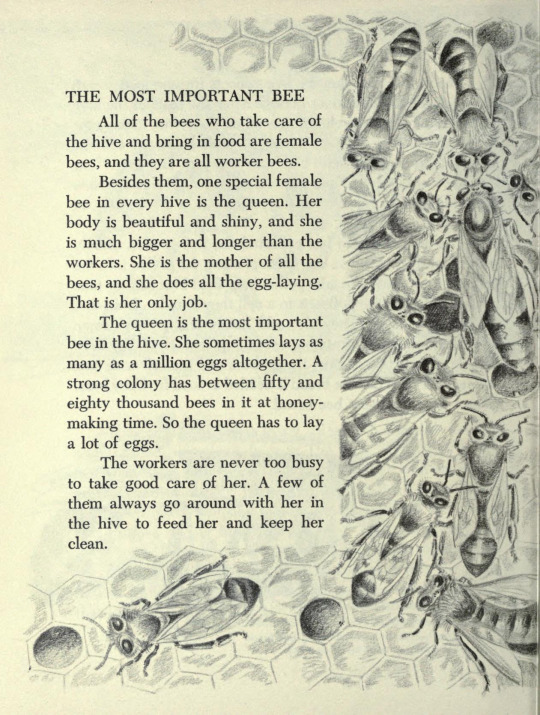
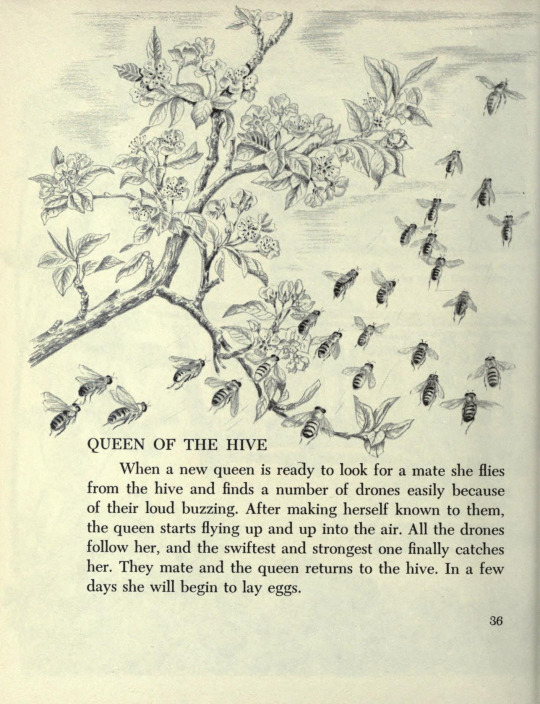
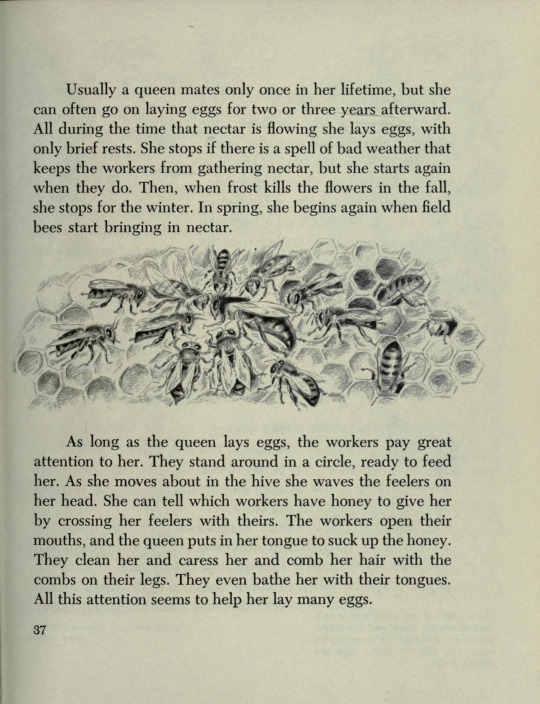
Queen bees, from The First Book of Bees by Albert B. Tibbets, 1952.
THE MOST IMPORTANT BEE
All of the bees who take care of the hive and bring in food are female bees, and they are all worker bees.
Besides them, one special female bee in every hive is the queen. Her body is beautiful and shiny, and she is much bigger and longer than the workers. She is the mother of all the bees, and she does all the egg-laying. That is her only job.
The queen is the most important bee in the hive. She sometimes lays as many as a million eggs altogether. A strong colony has between fifty and eighty thousand bees in it at honey-making time. So the queen has to lay a lot of eggs.
The workers are never too busy to take good care of her. A few of them always go around with her in the hive to feed her and keep her clean.
QUEEN OF THE HIVE
When a new queen is ready to look for a mate she flies from the hive and finds a number of drones easily because of their loud buzzing. After making herself known to them, the queen starts flying up and up into the air. All the drones follow her, and the swiftest and strongest one finally catches her. They mate and the queen returns to the hive. In a few days she will begin to lay eggs.
Usually a queen mates only once in her lifetime, but she can often go on laying eggs for two or three years afterward. All during the time that nectar is flowing she lays eggs, with only brief rests. She stops if there is a spell of bad weather that keeps the workers from gathering nectar, but she starts again when they do. Then, when frost kills the flowers in the fall, she stops for the winter. In spring, she begins again when field bees start bringing in nectar.
As long as the queen lays eggs, the workers pay great attention to her. They stand around in a circle, ready to feed her. As she moves about in the hive she waves the feelers on her head. She can tell which workers have honey to give her by crossing her feelers with theirs. The workers open their mouths, and the queen puts in her tongue to suck up the honey. They clean her and caress her and comb her hair with the combs on their legs. They even bathe her with their tongues. All this attention seems to help her lay many eggs.
9 notes
·
View notes
Text

A list of items useful when investigating a crime scene, from Criminal Investigation by Hans Gross (1893), translated from German and adapted by John Adam and J. Collyer Adam (1906).*
(Full text of the list is under the cut)
1. A supply of paper is of course a necessity. This should include several sheets of writing paper of the best quality. In an inquiry the ordinary Government official paper should never be used, it is generally of bad quality, and you may live to repent employing it.
2. Several envelopes of various sizes.
3. Several sheets of blotting paper.
4. A certain number of all the usual official printed blank forms, as inquest reports, warrants, summonses to witnesses, etc. One must not wait for the time of starting to put these in order; they should be replenished immediately on the return from each inquiry. With these should be carried pocket editions, text only, of the Penal Code, Code of Criminal Procedure, and Evidence Act.
5. A good map of the taluq or district in which one is about to travel. To save space it is better to have an unmounted map, as its use is comparatively infrequent.
6. The Investigating Officer will also be provided with pens and pencils. These should be of the best quality. Good pens mean quick and legible writing, whence economy of time and consequently greater care and accuracy in the inquiry. For steel nibs a good globe or ball-pointed pen is the best, as it does not penetrate or catch the paper, and thus permits swift and easy writing. The use of fountain pens is now almost universal in India among officials. The advise to be given as to them is, to shun cheap imitations by unknown makers. Nothing is more trustworthy than a fountain pen by a reliable maker—everyone has his own fancy—but a pen without such a guarantee and previous trial should be rigorously disregarded.
7. For ordinary pens a pocket ink bottle is necessary. Care should be taken to see that it shuts closely and is re-filled after each investigation. The ordinary sprint-top cases with indiarubber on the lid to seal the bottle are not very satisfactory. In fact all rubber articles perish very rapidly in India. For the fountain pen, a Swan Fountain Pen Ink-filler should be carried. It consists of a bottle of ink, with a filler forming the cork, contained in a cylindrical wooden or metal screw top case. The ordinary filler can be obtained for Re. 1 from any dealer in fountain pens, and will be found invaluable in travelling. As a reserve in case of need, a little nigrosine or ink powder should be carried. As this is supplied to and used in every office in India, nothing more need be said about it. The “Swan” Ink tablets, which can be had in various colours, in Nickel tubes, at 8 as. and Re. 1 are also very convenient.
8. A yard measure.
9. A pair of compasses.
10. A pedometer, though not perhaps indispensible, is most useful; it is the shape and size of a watch. If one wishes to measure a long distance, one sets the needles on all the dials (units, tens, &c.) at zero, puts the instrument in the pocket and walks off. For greater certainty one may put the instrument in one’s boot, when every step will certainly be registered. Thus better results are obtained than by merely counting paces, while the great advantage accrues that he who carries it can look about him and devote his attention to other matters, which is quite impossible while continually counting.
11. Tracing paper and cloth. The cloth is useful for removing traces of blood, and in all circumstances when paper is not strong enough.
12. A bottle of plaster of paris and another of oil. These are mainly of use for preserving footprints and impressions (see Chapter XIII.)
13. A brush. The brush is useful for taking impressions of solid objects and surfaces in relief, with moistened blotting paper; such as marks made by a tool, such as a chisel, cuts by a knife or hatchet, damage to material objects, etc. As to the method of doing this (see Chapter XII.)
14. Sealing Wax.
15. Two small glass tubes. These are useful for making quickly any simple experiment, for instance to see if a substance found in the body of a corpse or in the course of a search, be arsenic or not. Arsenic is the poison in most common use, hence it is important to detect it quickly, as its discovery may lead to an immediate arrest. These test tubes should be of clear, thin glass, closed at one end, from three to four inches long, and the thickness of a lead pencil, (see Chapter XVI).
16. Two wax candles of the length and thickness of one’s finger are often useful.
17. A compass.
18. An iron box with matches. If smokers themselves often forget their matches; how much more careful should Investigating Officers be in making sure of being always provided with this indispensible accessory.
19. A piece of soap. It is a great comfort to have a wash after a search, handling dirty clothes, perhaps dirty bodies, etc. Soap is also useful to take small impressions, as of keys, teeth (in case of bites), etc.
20. A good magnifying glass. This most useful friend should be mounted in a broad rim, so as to be protected from scratches, for a scratched magnifying glass is worse than useless.
21. A camel-hair brush. This is useful for oiling footmarks before taking the impression and also for removing traces of blood, etc.
22. Some gum arabic.
23. Some thick, smooth notepaper. Ordinary paper is too coarse and rough for preserving small articles, while glazed paper contains too many foreign admixtures.
24. The office seal. For greater convenience this may be used without a handle, so that it takes up no more room than a coin, say five shillings or five francs, or even a rupee.
25. A few sheets of manifolding paper. The use of this is too well known to require explanation. The best appliance to use when travelling is a hard and sharp lead pencil.
26. Some tissue paper. This is handy for taking impressions of fine surfaces, as of wood, a stone, etc., where blotting paper would be too rough.
27. A good watch.
_____
*The original text in German, Handbuch für Untersuchungsrichter als System der Kriminalistik, was published in 1893 by Hans Gross, who is credited with founding the discipline of criminology. In addition to translating the text from the 1904 edition into English, Adam and Adam (British legal officials in Madras) adapted it into an "Indian and Colonial Edition" with information of particular relevance to British officials in India during imperial rule. For more on the topic of policing and imperial rule in British India, see [1] [2] [3].
#1890s#1900s#criminal investigation#old books#vintage books#historical true crime#criminology#hans gross#victorian era
1 note
·
View note
Text


A Dwelling of Low Cost at Hackensack, N. J.
We publish, on page 24, in this issue, a modern dwelling of low cost, which has been erected for Mr. G. M. Fairchild, at Hackensack, N. J. The elevations are attractive and the plans are excellent. The underpinning is built of red brick, and the building above, of wood, is covered on the exterior with sheathing and then clapboards, and painted a brownish yellow, with light brown trimmings. The gables are shingled and painted red. The roofs are shingled and left to weather finish. The dimensions are: Front, 25 ft.; side, 33 ft. 6 in. Height of ceilings: Cellar, 7 ft.; first story, 9 ft.; second, 8 ft. 6 in. The interior is trimmed with pine throughout. The hall has a unique stairway, with windows at side. Parlor contains a mantel of neat design. Dining-room has an octagonal projection, giving both light and ventilation. Kitchen and pantries are fitted up complete. Stairs lead to cellar from rear entrance, with an exterior exit thereto. The second floor contains three good-sized bedrooms with closets. Cemented cellar contains laundry, furnace, and other necessary apartments. Cost, $1,600 complete, including furnace. Messrs. Cooper & Demarest, architects, Hackensack, N. J.
From Scientific American, Building Edition, vol. 25, no. 2, February 1898.
#old houses#house plans#old books#vintage books#scientific american#1890s#victorian era#architecture#houses#united states#new jersey
11 notes
·
View notes
Text

Admissions, Re-Admissions, Discharges, and Deaths, from January 1, 1865 to December 31, 1874.
From the Annual Report of the Royal Edinburgh Asylum for the Insane, 1874.
#mental health history#medical history#old books#vintage books#royal edinburgh asylum#united kingdom#scotland#history#1870s
0 notes
Photo
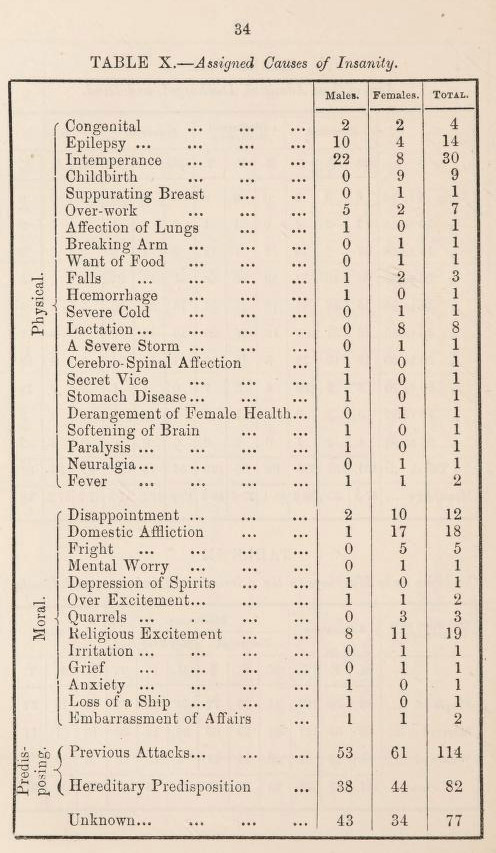
Assigned Causes of Insanity
Table from the Annual Report of the Royal Edinburgh Asylum for the Insane, 1874.
[ID: A printed table from an old book, titled "Assigned Causes of Insanity." The causes are categorized as "Physical" or "Moral", and counts are given for males, females, and total. In the "Physical" category: "Congenital, epilepsy, intemperance, childbirth, suppurating breast, over-work, affection of lungs, breaking arm, want of food, falls, hemmorhage, severe cold, lactation, a severe storm, cerebro-spinal affection, secret vice, stomach disease, derangement of female health, softening of brain, paralysis, neuralgia, fever." In the "Moral" category: "Disappointment, domestic affliction, fright, mental worry, depression of spirits, over excitement, quarrels, religious excitement, irritation, grief, anxiety, loss of a ship, embarrassment of affairs." There is also a "Predisposing" category consisting of "Previous attacks" and "Hereditary predisposition", and an entry for "Unknown". END ID]
#mental health history#old books#vintage books#causes of insanity#united kingdom#scotland#1870s#royal edinburgh asylum
29 notes
·
View notes
Photo
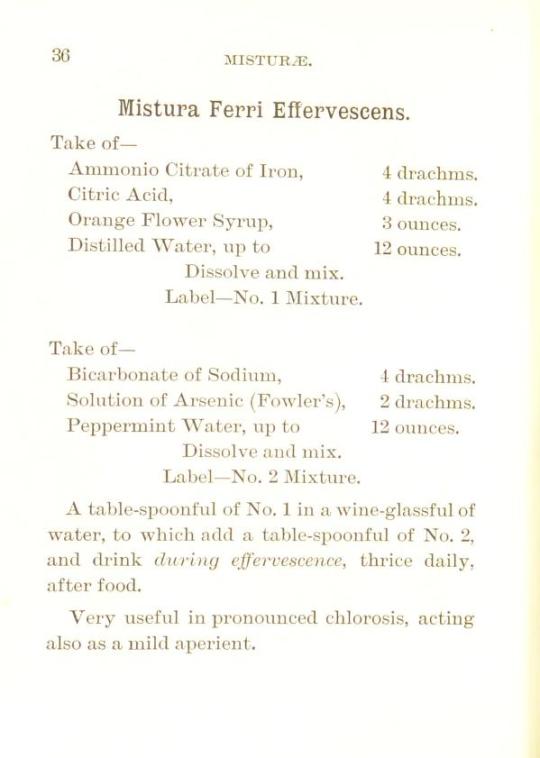
Got a little anemia? Little constipation? Have some Iron & Arsenic Alka-Seltzer
(From Pharmacopoeia of the Royal Infirmary, Edinburgh. By Charles Arthur. 1892.)
#please do not make this#old books#medicine#medical history#vintage books#pharmacopoeia#united kingdom#scotland#hospitals#victorian era#1890s
6 notes
·
View notes
Photo
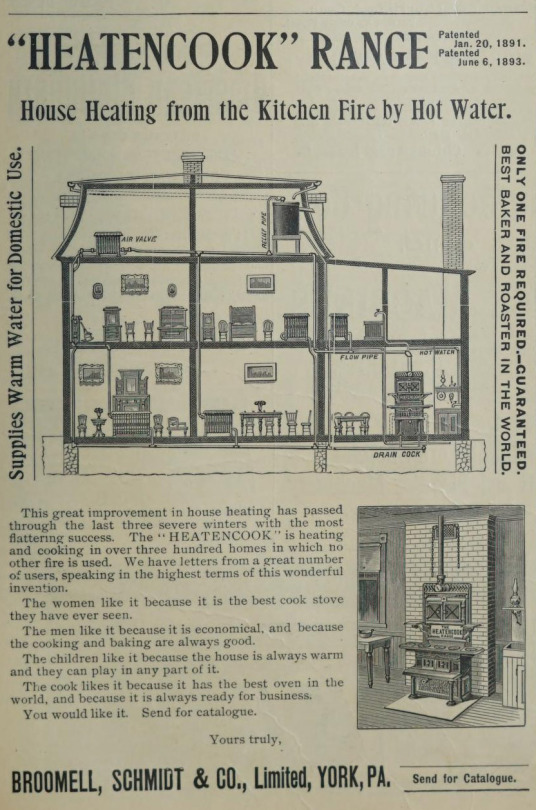
The women like it because it is the best cook stove they have ever seen.
The men like it because it is economical, and because the cooking and baking are always good.
The children like it because the house is always warm and they can play in any part of it.
The cook likes it because it has the best oven in the world, and because it is always ready for business.
You would like it. Send for catalogue.
Advertisement in Scientific American Building Edition, vol. 25, no. 1, January 1898.
2 notes
·
View notes